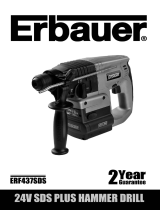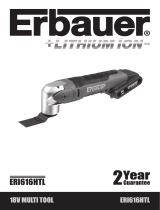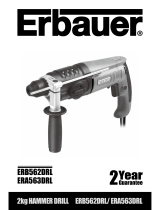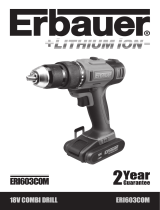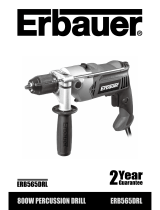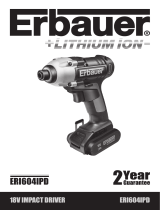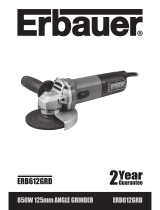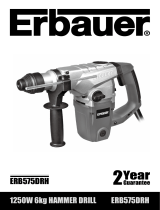Page is loading ...

36V SDS DRILL ERT576SDS
ERT576SDS

Original Instructions
(Version 1.0)

36V SDS DRILL ERT576SDS
CAUTION
This is a very powerful Drill.
When using this drill it is essential that the following rules for use are followed!
1. When drilling it is common that the core / drill bit jams in the material being drilled.
This will result in the drill trying to rotate around the drill bit and potentially come
out of your grip. This SDS Drill has a safety clutch mechanism. This safety clutch
mechanism will be activated and stop the drive to the drill bit BUT only if you
resist the initial forces caused by the jamming by securely holding the drill with
both hands. As this is a very powerful drill these forces are significant.
2. ALWAYS ensure that the front handle is firmly affixed and secure.
3. The Front and rear handle must be firmly held to resist any movement of the drill
when the core drill or drill bit becomes jammed.
4. ALWAYS use this drill when standing on a firm and secure platform or the ground.
(DO NOT USE ON LADDERS OR STEPS)
5. NEVER Start the Drill with the core or drill jammed in position.
6. DO NOT stretch to hold the drill. Do not drill above shoulder height or below Knee
height, as the drill cannot be securely held.
7. Never drill holes that are above the declared maximum size in the manual.
8. This drill is not designed for core drilling above the maximum drilling capacity in
masonry.

GUARANTEE
This product carries a 2 year guarantee. If your product develops a fault within this
period, you should in the first instance contact the retailer where the item was purchased.
This guarantee specifically excludes losses caused due to:
- Fair wear and tear
- Misuse or abuse
- Lack of routine maintenance
- Failure of consumable items (such as batteries)
- Accidental damage
- Cosmetic damage
- Failure to follow manufacturer’s guidelines
- Loss of use of the goods
This guarantee does not affect your statutory rights. This guarantee is only valid in the UK.
For further technical advice, spare parts or repair service (outside of guarantee) please contact
the customer helpline number on 0345 607 6380.
Congratulations on your purchase of a quality power tool from Erbauer (UK) Ltd. This
product should give you reliable service but for your peace of mind this
power tool does carry a 2 year guarantee, the terms of which are detailed below.
If this product develops a fault within the guarantee period contact your retailer.
Please retain this handbook in case you need to refer to safety, care or guarantee
information in the future.

36V SDS DRILL ERT576SDS
GENERAL POWER TOOL SAFETY WARNINGS
Warning: Read all safety warnings and all instructions. Failure to follow the warnings
and instructions may result in electric shock, fire and/or serious injury.
Save all warnings and instructions for future reference.
The term “power tool” in the warnings refers to your electric (corded) power tool or battery-
operated (cordless) power tool.
1. Work area safety
a. Keep work area clean and well lit. Cluttered or dark areas invite accidents.
b. Do not operate power tools in explosive atmospheres, such as in the presence
of flammable liquids, gases or dust. Power tools create sparks which may ignite the
dust or fumes.
c. Keep children and bystanders away while operating a power tool. Distractions
can cause you to lose control.
2. Electrical safety
a. Power tool plugs must match the outlet. Never modify the plug in any way. Do
not use any adapter plugs with earthed (grounded) power tools. Unmodified plugs
and matching outlets will reduce risk of electric shock.
b. Avoid body contact with earthed or grounded surfaces, such as pipes,
radiators, ranges and refrigerators. There is an increased risk of electric shock if your
body is earthed or grounded.
c. Do not expose power tools to rain or wet conditions. Water entering a power tool
will increase the risk of electric shock.
d. Do not abuse the cord. Never use the cord for carrying, pulling or unplugging
the power tool. Keep cord away from heat, oil, sharp edges or moving parts.
Damaged or entangled cords increase the risk of electric shock.
e. When operating a power tool outdoors, use an extension cord suitable for
outdoor use. Use of a cord suitable for outdoor use reduces the risk of electric shock.
f. If operating a power tool in a damp location is unavoidable, use a residual current
device (RCD) protected supply. Use of an RCD reduces the risk of electric shock.
3. Personal safety
a. Stay alert, watch what you are doing and use common sense when operating
a power tool. Do not use a power tool while you are tired or under the influence
of drugs, alcohol or medication. A moment of inattention while operating power tools
may result in serious personal injury.
b. Use personal protective equipment. Always wear eye protection. Protective
equipment such as dust mask, non-skid safety shoes, hard hat, or hearing protection
used for appropriate conditions will reduce personal injuries.
c. Prevent unintentional starting. Ensure the switch is in the off-position before
connecting to power source and/or battery pack, picking up or carrying the tool.
Carrying power tools with your finger on the switch or energising power tools that have
the switch on invites accidents.
d. Remove any adjusting key or wrench before turning the power tool on.
A wrench or a key left attached to a rotating part of the power tool may result in personal injury.
e. Do not overreach. Keep proper footing and balance at all times. This enables
better control of the power tool in unexpected situations.

f. Dress properly. Do not wear loose clothing or jewellery. Keep your hair,
clothing and gloves away from moving parts. Loose clothes, jewellery or long hair
can be caught in moving parts.
g. If devices are provided for the connection of dust extraction and collection
facilities, ensure these are connected and properly used. Use of dust collection can
reduce dust-related hazards.
4. Power tool use and care
a. Do not force the power tool. Use the correct power tool for your application. The
correct power tool will do the job better and safer at the rate for which it was designed.
b. Do not use the power tool if the switch does not turn it on and off. Any power
tool that cannot be controlled with the switch is dangerous and must be repaired.
c. Disconnect the plug from the power source and/or the battery pack from the
power tool before making any adjustments, changing accessories, or storing
power tools. Such preventive safety measures reduce the risk of starting the power tool
accidentally.
d. Store idle power tools out of the reach of children and do not allow persons
unfamiliar with the power tool or these instructions to operate the power tool.
Power tools are dangerous in the hands of untrained users.
e. Maintain power tools. Check for misalignment or binding of moving parts,
breakage of parts and any other condition that may affect the power tool’s
operation. If damaged, have the power tool repaired before use. Many accidents
are caused by poorly maintained power tools.
f. Keep cutting tools sharp and clean. Properly maintained cutting tools with sharp
cutting edges are less likely to bind and are easier to control.
g. Use the power tool, accessories and tool bits etc. in accordance with these
instructions, taking into account the working conditions and the work to be
performed. Use of the power tool for operations different from those intended could
result in a hazardous situation.
5. Battery tool use and care
a) Recharge only with the charger specified by the manufacturer. A charger that
is suitable for one type of battery pack may create a risk of fire when used with another
battery pack.
b) Use power tools only with specifically designated battery packs. Use of any
other battery packs may create a risk of injury and fire.
c) When battery pack is not in use, keep it away from other metal objects, like
paper clips, coins, keys, nails, screws or other small metal objects, that can
make a connection from one terminal to another. Shorting the battery terminals
together may cause burns or a fire.
d) Under abusive conditions, liquid may be ejected from the battery; avoid
contact. If contact accidentally occurs, flush with water. If liquid contacts eyes,
additionally seek medical help. Liquid ejected from the battery may cause irritation or
burns.
6. Service
a) Have your power tool serviced by a qualified repair person using only identical
replacement parts. This will ensure that the safety of the power tool is maintained.

36V SDS DRILL ERT576SDS
HAMMER SAFETY WARNINGS
1. Wear ear protectors when use impact drilling. Exposure to noise can cause hearing loss.
2. Use auxiliary handle(s), if supplied with the tool. Loss of control can cause personal
injury.
3. Hold power tool by insulated gripping surfaces, when performing an operation
where the cutting accessory may contact hidden wiring. Cutting accessory
contacting a “live” wire may make exposed metal parts of the power tool “live” and could
give the operator an electric shock.
4. Remove the battery pack from the drill before carrying out adjustments.
5. Do not expose to rain or water.
6. Do not store the battery pack in temperatures over 40
o
C.
7. Always charge the battery pack between temperatures 0
o
C to 30
o
C. Ideal charging
temperature is 18
o
C to 24
o
C.
8. Only use the charger and the battery pack provided to work together.
9. Avoid short circuit of the battery pack connections (screws & nails).
10. Do not incinerate or burn the battery pack, it may explode.
11. Do not charge a damaged battery pack.
12. Replace any damaged supply cords on your charger.
13. Always disconnect the charger power supply before making or breaking the connections to
the battery pack.
14. Battery pack and charger will be warm during charging, this is normal.
15. When not in use, remove a charged battery pack from the charger.
16. Always remove the battery pack from the charger immediately after re-charging is
completed.
17. Your drill and battery pack will be warm when working, this is normal.
18. Do not dispose of batteries in fire, or with household waste. Return exhausted batteries to
your local collection or recycling point.
19. Always check walls, floors and ceilings for hidden power cables and pipes.
20. Accessories and metal parts can become very hot during working. Never touch them by
bare hand.
FOR CHARGER
This appliance can be used by children aged from 8 years and
above and persons with reduced physical, sensory or mental
capabilities or lack of experience and knowledge if they have
been given supervision or instruction concerning use of the
appliance in a safe way and understand the hazards involved.
Children shall not play with the appliance. Cleaning and user
maintenance shall not be made by children without supervision.
If the supply cord is damaged, it must be replaced by the
manufacturer, its service agent or similarly qualified persons in
order to avoid a hazard.
1. Charger is double insulated for additional electrical safety.
2. Charger is for indoor use only.
3. Never charge damaged batteries as these can short circuit and over heat.
4. When the charger is in use it MUST be supervised , if there is any evidence of overheating
then IMMEDIATELY disconnect the charger from the power supply.

5. If gas or smoke is emitted from the battery during charging switch off the power supply ,
and move to a well vented area to allow the fumes to vent to atmosphere.
Caution is there is leaking liquid from the battery wear protective clothing, glasses and
clothes as this can be acidic.
6. Always disconnect battery charger and remove battery from charger when the charging is
complete.
7. Only use the battery charger specifically stated on the base of the battery.
FOR BATTERY
1. Always remove the battery pack from the charger immediately after re-charging is completed.
2. When not in use, remove a charged battery pack from the charger.
3. Do not charge a damaged battery pack.
4. Do not charge non-rechargeable batteries.
5. Do not install the battery backwards so the polarity is reversed.
6. Do not connect the positive terminal and negative terminal of the battery to each other with
any metal object (such as wire).
7. Do not carry or store battery together with necklaces, hairpins or other metal objects.
8. Do not pierce the battery with nails, strike the battery with a hammer, step on the battery or
otherwise subject it to strong impacts or shocks.
9. Do not solder directly onto the battery.
10. Do not expose battery to water or salt water, or allow the battery to get wet.
11. Do not disassemble or modify the battery. The battery contains safety and protection
devices, which, if damaged, may cause the battery to generate heat, explode or ignite. The
protection circuit module provided with battery packs is not to be used as a substitute for a
shut-off switch.
12. Do not place the battery in or near fire, on stoves or other high temperature locations. Do
not place the battery in direct sunlight, or use or store the battery inside cars in hot weather.
Heating the battery can damage the safety circuitry, which can cause additional heating,
rupture or ignition of the battery. Using the battery in this manner may also result in a loss of
performance and a shortened life expectancy.
13. Do not place the battery in microwave ovens, high-pressure containers or on induction cookware.
14. If you intend to store a battery for a period without use then store battery at room
temperature (19°C to 25°C), charged to about 30 – 50% of capacity. When storing for very
long periods boost-charge the battery once per year to prevent over discharge.
15. Always charge the battery in a temperature range of 0°C to 30°C and discharge in a
temperature range of 0°C to 75°C.
16. The battery pack and charger will be warm during charging, this is normal.
17. Do not continue charging the battery if it does not recharge within the specified charging
time. Doing so may cause the battery to become hot, explode or ignite. The temperature
range over which the battery can be charged is 0°C to 30°C. Charging the battery at
temperatures outside this range may cause severe damage to the battery or reduce battery
life expectancy.
18. When the battery is worn out, insulate the terminals with adhesive tape or similar materials
before disposal.
19. Do not dispose of batteries in fire, or with household waste. Return exhausted batteries to
your local collection or recycling point.
Warning: If a small amount of electrolyte should leak from the battery pack
under extremes of temperature or after heavy use, then wash off immediately
from your skin and hands using clean water. For eye contact, rinse thoroughly with clean
water and seek medical treatment immediately.

36V SDS DRILL ERT576SDS
ADDITIONAL SAFETY WARNING FOR CONSTRUCTION DUST
The updated Control of Substances Hazardous to Health Regulations 1st October 2012 now
also targets to reduce the risks associated with silica, wood and gypsum dusts.
Construction workers are one of the at-risk groups within this because of the dust that they
breathe: silica dust is not just a nuisance; it is a real risk to your lungs!
Silica is a natural mineral present in large amounts in things like sand, sandstone and granite. It
is also commonly found in many construction materials such as concrete and mortar. The silica
is broken into very fine dust (also known as Respirable Crystalline Silica or RCS) during many
common tasks such as cutting, drilling and grinding
Breathing in very fine particles of crystalline silica can lead to the development of:
Lung cancer
Silicosis
Chronic Obstructive Pulmonary Disorder (Chronic obstructive pulmonary disease (COPD))
And breathing in fine particles of wood dust can lead to the development of Asthma
The risk of lung disease is linked to people who regularly breathe construction dust over a
period of time, not on the odd occasion.
To protect the lung, the COSHH Regulations sets a limit on the amount of these dusts that you
can breathe (called a Workplace Exposure Limit or WEL) when averaged over a normal working
day. These limits are not a large amount of dust: when compared to a penny it is tiny – like a
small pinch of salt:
This limit is the legal maximum; the most you can breathe after the right controls have been
used.
How to reduce the amount of dust?
1. Reduce the amount of cutting by using the best sizes of building products.
2. Use a less powerful tool e.g. a block cutter instead of angle grinder.
3. Using a different method of work altogether – e.g. using a nail gun to direct fasten cable
trays instead of drilling holes first.
Please always work with approved safety equipment, such as those dust masks that specially
designed to filter out microscopic particles and use the dust extraction facility at all time.
For more information please see the HSE website:
http://www.hse.gov.uk/construction or http://www.hse.gov.uk/pubns/cis69.pdf
Warning: Some dust particles created by power sanding, sawing, grinding, drill
and other construction jobs contain chemicals known to cause cancer, birth
defects or other reproductive harm. Some examples of these chemicals are:
• Lead from lead-based paints.
• Crystalline silica from bricks and cement and other masonry products.
• Arsenic and chromium from chemically treated timber.
Your risk from these exposures varies, depending upon how often you do this type of work. To
reduce your exposure to these chemicals:

• Work in a well-ventilated area.
• Work with approved safety equipment, such as those dust masks that are specially designed
to filter microscopic particles.
VIBRATION
The European Physical Agents (Vibration) Directive has been brought in to help reduce
hand arm vibration syndrome injuries to power tool users. The directive requires power tool
manufacturers and suppliers to provide indicative vibration test results to enable users to
make informed decisions as to the period of time a power tool can be used safely on a daily
basis and the choice of tool.
Further Advice can be found at www.hse.gov.uk
Vibration total values (triax cover sum) determined according to EN60745:
Hammer drilling into
concrete
Vibration emission value α
h,HD
=11.27m/s
2
Uncertainty K = 1.5m/s²
Chiselling
α
h,CHeq
=10.25m/s²
Uncertainty K=1.5m/s²
The declared vibration emission value should be used as a minimum level and should be
used with the current guidance on vibration.
Calculating the actual period of the actual period off use can be difficult and the HSE website
has further information.
The declared vibration emission been measured in accordance with a standardised test
stated above and may be used to compare one tool with another tool.
The declared vibration emission value may also be used in a preliminary assessment of exposure.
Warning: The vibration emission value during actual use of the power tool can differ
from the declared value depending on the ways in which the tool is used dependant on
the following examples and other variations on how the tool is used:
How the tool is used and the materials being cut or drilled.
The tool being in good condition and well maintained
The use the correct accessory for the tool and ensuring it is sharp and in good condition.
The tightness of the grip on the handles.
And the tool is being used as intended by its design and these instructions.
While working with this power tool, hand/arm vibrations occur. Adopt the correct
working practices in order to reduce the exposure to vibration.
This tool may cause hand-arm vibration syndrome if its use is not adequately
managed.

36V SDS DRILL ERT576SDS
Warning: Identify safety measures to protect the operator that are based on an esti-
mation of exposure in the actual conditions of use (taking account of all parts of the
operating cycle such as the times when the tool is switched off and when it is running idle in
addition to the trigger time).Note The use of other tools will reduce the users’ total working
period on this tool.
Helping to minimise your vibration exposure risk.
ALWAYS use sharp chisels, drills and blades
Maintain this tool in accordance with these instructions and keep well lubricated
(where appropriate)
Avoid using tools in temperatures of 10ºC or less
Plan your work schedule to spread any high vibration tool use across a number of days.
Health surveillance
All employees should be part of an employer’s health surveillance scheme to help identity any
vibration related diseases at an early stage, prevent disease progression and help employees
stay in work.
Double insulation
The charger is double insulated. This means that all the external metal parts are electrically
insulated from the mains power supply. This is done by placing insulation barriers between the
electrical and mechanical components making it unnecessary for the tool to be earthed.
Vibration and noise reduction
To reduce the impact of noise and vibration emission, limit the time of operation, use low-
vibration and low-noise operating modes as well as wear personal protective equipment.
Take the following points into account to minimize the vibration and noise exposure risks:
1. Only use the product as intended by its design and these instructions.
2. Ensure that the product is in good condition and well maintained.
3. Use correct application tools for the product and ensure they in good condition.
4. Keep tight grip on the handles/grip surface.
5. Maintain this product in accordance with these instructions and keep it well lubricated
(where appropriate).
6. Plan your work schedule to spread any high vibration tool use across a number of days.
Familiarise yourself with the use of this product by means of this instruction
manual. Memorise the safety directions and follow them to the letter. This will
help to prevent risks and hazards.
1. Always be alert when using this product, so that you can recognise and handle risks early.
Fast intervention can prevent serious injury and damage to property.
2. Switch off and disconnect from the power supply if there is any malfunction. Have the
product checked by a qualified specialist and repaired, if necessary, before you put it into
operation again.
Residual risks
Even if you are operating this product in accordance with all the safety requirements,
potential risks of injury and damage remain. The following dangers can arise in connection
with the structure and design of this product:
1. Health defects resulting from vibration emission if the product is being used over long
periods of time or not adequately managed and properly maintained.

2. Injuries and damage to property due to broken application tools or the sudden impact of
hidden objects during use.
3. Danger of injury and property damage caused by flying objects.
Warning: This product produces an electromagnetic field during operation! This field may
under some circumstances interfere with active or passive medical implants! To reduce
the risk of serious or fatal injury, we recommend persons with medical implants to consult their
doctor and the medical implant manufacturer before operating this product!
Important note:
Be sure the supply is the same as the voltage given on the rating plate for the charger. The
charger is fitted with a two-core cable and plug.
Remove the mains plug from socket before carrying out any adjustment or servicing.
Torque limiter
There is a clutch in your rotary hammer drill.
The torque limiter will actuate when a certain torque level is reached. The motor will
disengage from the output shaft. When this happens, the bit will stop turning.
As soon as the torque limiter actuates, switch off the tool immediately and remove the drill bit
from the hole completely. This will help prevent premature wear of the tool.

36V SDS DRILL ERT576SDS
SYMBOLS
To reduce the risk of injury, user must read instruction manual
Warning
Double insulation
Indoor use only
1h charging time for ERT577BAT
Do not expose to rain or water
Do not burn Wear gloves
Always charge the battery pack between temperatures 0°C to 30°C. Ideal charging
temperature is 18°C to 24°C.
This symbol indicates that this battery contains lithium. This battery shall be brought
to your shop to be recycled.
Wear ear protection Wear eye protection Wear dust mask
Do not dispose of batteries, Return exhausted batteries to your local collection
or recycling point.
Waste electrical products should not be disposed of with household waste.
Please recycle where facilities exist. Check with your Local Authority
or retailer for recycling advice.
yyWxx Manufacturing date code; Year of manufacturing (20yy) and week of manufacturing
(Wxx);
max30 C
1h

1. ADJUSTABLE DEPTH GAUGE
2. DUST PROTECTION CAP
3. TOOL HOLDER LOCKING SLEEVE
4. FUNCTION MODE SELECTION SWITCH
5. ON/OFF SWITCH (WITH VARIABLE SPEED CONTROL)
6. FORWARD AND REVERSE ROTATION CONTROL
7. BATTERY PACK
8. BATTERY PACK RELEASE BUTTON
9. AUXILIARY HANDLE
10. CHARGER
11. CHARGED INDICATOR LIGHT (GREEN)
12. CHARGING INDICATOR LIGHT (RED)
13. CHARGER STAND
1
4
7
5
89
10
13
11
12
6
2
3

36V SDS DRILL ERT576SDS
36V
0-1050/min
0-4600bpm
2.5J
Li-Ion
1hr
2.0Ah Li-ion
2
13mm
30mm
26mm
2.8kg
100-240V~ 50/60Hz
36V
2.0A
NOISE INFORMATION
A weighted sound pressure L
pA
: 86dB(A) K
pA
=3.0dB(A)
A weighted sound power L
wA
: 97dB(A) K
wA
=3.0dB(A)
Wear ear protection when sound pressure is over 80dB(A)
ACCESSORIES
Auxiliary handle 1pc
Depth gauge 1pc
1hr charger 1pc
2.0 Ah Li-ion battery pack 2pcs
Charger stand 2pcs
TECHNICAL DATA
Voltage
No load speed
Impact rate
Impact energy
Battery type
Charger time
Battery capacity
Battery pack quantity
Max. Drilling capacity
Steel
Wood
Masonry
Machine weight (without battery)
Charger input
Charger output

OPERATING INSTRUCTIONS
Note: Before using the tool, read the instruction
book carefully.
Intended Use
The machine is intended for hammer drilling in
concrete, brick and stone. It is also suitable for drilling
without impact in wood, metal, ceramic and plastic.
CHARGING PROCEDURE
1. CHARGING THE BATTERY PACK
Your battery pack is UNCHARGED and you must
charge once before use. When you charge the new
battery or one which has not been used for long
periods of time, it may not reach full charge until after
you have discharged it fully in use and recharge it
several times.
Warning: The charger and battery pack are
specifically designed to work together so do
not attempt to use any other devices. Never insert
or allow metallic objects into your charger or battery
pack connections because an electrical failure and
hazard will occur.
2. INSTALL THE CHARGER STANDS (See Fig.1-
3)
Slide the two charger stands (13) into the both
grooves on back of the charger. The charger can
stand as shown in Fig.3.
3. HOW TO CHARGE YOUR BATTERY (See Fig. 4)
Connect the battery charger to the power supply and
the green light (11) will illuminate. Slide the battery
pack (7) into the charger to make the connections.
The green light (11) will be off and the red light (12)
will illuminate to show charging has started. When
charging is completed the green light (11) will
illuminate while the red light (12) is off.
Warning:
When battery charge runs out after
continuously use or exposure to direct sunlight
or heat, allow time for the tool to cool down before
re-charging to achieve the full charge.
10
7
11
12
13
1
2
5
14
Fig. 1
Fig. 2
Fig. 3
Fig. 4
Fig. 5-1
Fig. 5-2
Fig. 6-1
Fig. 6-2
Fig. 7
Fig. 8
Fig. 9

36V SDS DRILL ERT576SDS
NOTE:
Red Flashing
Green Off
Defective battery
Red ON
Green Off
Charging
Green ON
Red Off
Power On and Fully Charged
Green Flashing
Red Off
The temperature of battery pack is
less than 0
o
C or more than 45
o
C
4. TO REMOVE OR INSTALL BATTERY PACK
(See Fig. 5-1 5-2)
Depress the battery pack release button to release
and slide the battery pack out from your tool(See
FIG.5-1). After recharge, slide it back into your
tool(See FIG.5-2). A simple push and slight pressure
will be sufficient.
OPERATION
1. INSERTING AND REMOVING DRILL BIT IN
SDS
Take care that the dust protection cap (2) is not
damaged when changing tools.
-INSERTING (See Fig. 6-1)
Clean and lightly oil the bit before inserting. Insert the
dust-free bit into the bit holder with a twisting motion
until it latches.
The bit locks itself. Check the locking by pulling on the
tool.
-REMOVING (See Fig. 6-2)
Retract back the bit holder locking sleeve (3) and pull
out the bit.
Warning:
Your new Rotary Hammer generates
powerful forces to get your job done quickly and
effectively. These forces may cause inferior quality
SDS bits to break and jam in the chuck, We therefore
recommend that only high quality SDS bits be used
with this tool.
10
7
11
12
13
1
2
5
14
Fig. 1
Fig. 2
Fig. 3
Fig. 4
Fig. 5-1
Fig. 5-2
Fig. 6-1
Fig. 6-2
Fig. 7
Fig. 8
Fig. 9

2. AUXILIARY HANDLE (See Fig. 7)
Slide the handle onto the hammer and rotate to the
desired working position. To clamp the auxiliary handle
rotates the handle clockwise. To loosen the auxiliary
handle, rotate the handle anti-clockwise.
Warning:
Always use the auxiliary handle.
3. ADJUSTABLE DEPTH GAUGE (See Fig. 7)
Fit the drill bit into the chuck. Loosen the depth gauge
by rotating the handle anti-clockwise. Slide the depth
gauge until the distance between the depth gauge end
and the drill end is equal to the depth of hole/screw
you wish to make. Then clamp the depth gauge by
rotating the handle clockwise.
4. ON/OFF SWITCH WITH VARIABLE SPEED
CONTROL (See Fig. 2)
Depress to start and release to stop your tool. This
tool has a variable speed switch (5) that delivers higher
speeds with increased trigger pressure - speed is
controlled by varying the pressure applied to the switch.
5. SWITCH LOCK (See Fig. 8)
The switch trigger can be locked in the OFF position.
This helps to reduce the possibility of accidental starting
when not in use. To lock the switch trigger, place the
direction of rotation control in the center position.
6. FORWARD AND REVERSE ROTATION
CONTROL (See Fig. 8)
With the drill pointing away from you, push the
forward/reverse-lever to the left “
“for forward
rotation. Push the forward/reverse-lever to the right for
reverse rotation “
“.
Warning:
Never change the direction of
rotation while the tool is rotating, wait until
it has stopped.
7. FUNCTION MODE SELECTION (See Fig. 9)
The operation of the gearbox for each application is set
with the function mode selection switch (4). To change
between functions, depress the unlocking button (14)
and rotate the selector to the desired operating mode.
10
7
11
12
13
1
2
5
14
Fig. 1
Fig. 2
Fig. 3
Fig. 4
Fig. 5-1
Fig. 5-2
Fig. 6-1
Fig. 6-2
Fig. 7
Fig. 8
Fig. 9

36V SDS DRILL ERT576SDS
For simultaneous drilling and
impacting of concrete or
masonry, choose the Hammer
drilling position.
For drilling into steel, wood
and plastics choose the Rotary
drilling position.
For impacting only - for
light chipping, chiseling and
demolition applications choose
the Hammer position.
Warning:
The operating mode selector switch
may be actuated only at a standstill.
HANDY HINTS
General
1. Your cordless drill is useful for drilling holes on
concrete.
2. To prolong the life of your drill never overload it;
if it slows down while drilling, remove and try again
using less force on the drill. If the drill is straining
because the battery pack charge is low, stop and
recharge the battery pack.
3. Always use only a soft, dry cloth to clean your
drill; never use any detergent or alcohol. Disconnect
the charger from the mains supply before cleaning.
Hole drilling
1. When attempting to drill a large diameter hole,
it is sometimes best to start with a smaller drill bit
then work up to the required size. This prevents
overloading the drill.
2. If the drill bit snags, switch off the drill immediately
to prevent permanent damage. Try the reverse drive
to remove the bit.
3. Keep the drill in line with the hole. Ideally, if the
angle is changed during drilling it could cause the bit
to break.
4. Frequently remove the drill bit from the hole when
drilling deep holes to allow the dust to be ejected
from the hole.

POSSIBLE PROBLEMS AND SOLUTIONS
Should you encounter any problems when using
your cordless drill, check the following list.
1. On/Off switch will not depress
The switch will not depress if the forward and
reverse rotation selector is in the locked position.
Move to the forward or reverse position and try again.
2. On/Off switch depresses but drill will not work
The cordless drill needs sufficient charge in the
battery pack to work. The battery charge will deplete
if not used for a long period of time. Try recharging
the battery pack.
3. The drill body gets hot following extensive
use
Under normal load condition the body, trigger and
battery pack will heat up as the energy absorbed in the
drilling operation produces heat. This is quite normal.
Simply allow the drill to cool off for a few minutes.
4. The battery pack gets warm during use
The power-draw from the battery generates heat.
This is increased as the energy draw increases. The
LED will flash when the battery is getting extremely
hot. Should you desire to cool it down, simply allow
the drill to cool off prior to continuing work.
5. The battery pack gets warm when charging
This is normal; it is a result from the stepping down
of the chemical reactions inside the batteries during
the charging process.
6. The charger will get warm during charging
This is normal; it is a result of the stepping down of
the main supply from 110-240Vac to 36Vdc.
7. HOT battery pack protection
The normal charging temperature is between 0
o
C
and 45
o
C. When the allowable battery temperature
of 45
o
C is exceeded, charging will suspend until it
has reached the correct temperature. The normal
discharging/working temperature is between 0
o
C
and 75
o
C. When the allowable battery temperature
of 75
o
C is exceeded, the electronic control switches
off the power tool until the temperature is in the
optimum temperature range again.
/

